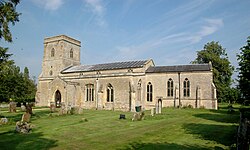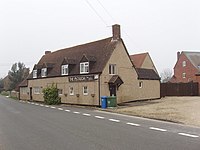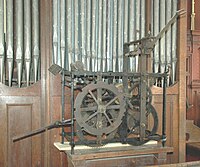Merton, Oxfordshire
| Merton | |
| Oxfordshire | |
|---|---|
 St Swithun's parish church | |
| Location | |
| Grid reference: | SP576177 |
| Location: | 51°51’18"N, 1°9’50"W |
| Data | |
| Population: | 424 (2011) |
| Post town: | Bicester |
| Postcode: | OX25 |
| Dialling code: | 01865 |
| Local Government | |
| Council: | Cherwell |
| Parliamentary constituency: |
Banbury |
| Website: | mertonparishcouncil.co.uk |
Merton is a village by the River Ray in the midst of Oxfordshire, about four miles south of Bicester. The 2011 Census recorded the parish's population as 424.[1]
The name 'Merton' is from the Old English 'mere tun', which is to say a village by a lake.[2]
Contents
History
In 1978 a Middle Bronze Age spearhead was found at West End Farm on the northwestern side of the village.[3]
The Domesday Book of 1086 records the village as Meretone and that before the Norman conquest the manor was held by Hacun (a Danish or Norse name),[4] who also held the nearby manor of Piddington.[5] The Domesday Book records that by 1086 Countess Judith of Lens, a niece of William the Conqueror held the manor.[4] Countess Judith was betrothed to Simon I de Senlis but refused to marry him and fled England. William I confiscated her estates and allowed Simon to marry Judith's eldest daughter Maud. Simon received estates including Merton as the Honour of Huntingdon.[4]
In 1152 or 1153 Simon's son Simon II de Senlis, Earl of Huntingdon-Northampton gave Merton to the Knights Templar. In 1185 the manor covered seven hides, making it their largest estate in Oxfordshire.[4] In 1313, after the suppression of the Templars, the King granted Merton to the Knights Hospitaller.[4] In 1540 the Hospitallers were themselves suppressed in the Dissolution of the Monasteries and surrendered Merton to the Crown.
The Knights Templar established a watermill in the parish.[4] The earliest known record of it is from 1156 to 66.[4] West of St Swithun's is rubblestone tithe barn that may have been built in the 15th century[6] or early 16th century.[7] It has a queen post roof and is thatched.[6] In the late 20th century it was converted into four homes.[7]
In 1554, Robert Doyley of Chiselhampton and his son John acquired the manor;[4] John's widow, Anne, married Sir James Harington in 1601, after which the manor continued in the line of the Harington Baronets. A later Sir James Harington served as a major-general in the Parliamentarian army and so lost his baronetcy and estates at the Restoration: he fled to Europe and died in exile.[4]
In 1662, Lady Katherine, who claimed to have remained a Royalist, received the estate in trust, reverting at her death to her son Sir Edmund Harington, the 4th Baronet.[4] The Harington baronets finally lost Merton in after mortgaging it in 1740 to pay gambling debts and going into exile with the Young Pretender.
Modernity
There were small enclosures of land in the parish in the 14th and 16th centuries but an open field system of farming prevailed until 1763.[4] In the 1761 Parliamentary election the owner of the estate, Sir Edward Turner was elected as Member for Penryn in Cornwall, and achieved an Inclosure Act for the parish.[4] This extinguished all common land rights in Merton and assigned most of the land to Sir Edward.[4]
In 1814 one of the earliest National Schools to be established under the auspices of the National Society for Promoting Religious Education was opened in Merton.[4] A new stone-built school building, complete with lodging for the matron, was completed in 1829.[4] Ownership and management of the school were transferred to the vicar and churchwardens in 1870.[4] The school was enlarged in 1872 and 1893.[4] The number of pupils then declined and in 1913 the school was closed and 12 pupils were transferred to Ambrosden.[4] In 1930 the house and school were sold and became a private home.[4]
Church and chapel
The Church of England parish church, St Swithun, is in the Decorated Gothic style, built early in the 14th century.[8] It has a south aisle, linked with the nave by an arcade of four bays.[4] Late in the 15th century the Perpendicular Gothic clerestory was added to the nave.[4] The chancel windows and one window in the south aisle are also Perpendicular Gothic.[8] The font is much older than the church, dating from late in the 12th century.[4]
St Swithun's had a north aisle but it was demolished in the 15th or 16th century.[8] Its arcade of three bays was blocked up and remains in the north wall of the nave.[4] The tower had a spire but it became unsafe and in 1796 it was removed.[8]
St Swithun's most notable monuments are wall-mounted ones in the chancel commemorating John Doyley (died 1593) and his wife, Elizabeth Poole (died 1621) and Richard Harrington (died 1712).[9] The Poole monument has strapwork and Tuscan columns but is significantly mutilated[8] and in want of restoration.
A turret clock for St Swithun's was made late in the 17th century.[10] Its original dial had only an hour hand.[10] In 1867 this was replaced with a new dial that has both hour and minute hands.[10] Some time after 1989 a new turret clock was installed; the 17th century original is now displayed in the nave.
The Gothic Revival architect Charles Buckeridge restored St Swithun's from 1865[8] until 1872.[4] St Swithun's had been decorated with mediæval wall paintings, once brightly coloured but by 1823 described as "dim with age".[4] During the restoration work it was found impossible to remove the layers of whitewash covering them.[4] St Swithun's is a Grade I listed building.[11]
In 1565 the Crown sold the advowson and rectory to William Petre, who in 1572 gave both to Exeter College, Oxford.[4]
A Congregational chapel was built in 1890.[4] It was still in use for worship in 1953.[4]
About the village
Merton used to have a public house, the Plough Inn, whose building is partly Tudor. In the 2000s the owners closed the pub, and in the 2010s it was converted into housing. Since the Plough's closure the village has held real ale festivals at least once a year in its village hall.[12]
Outside links
| ("Wikimedia Commons" has material about Merton, Oxfordshire) |
References
- ↑ "Merton Parish". nomis. Durham University for the Office for National Statistics. https://www.nomisweb.co.uk/reports/localarea?compare=E04008061.
- ↑ Arkell 1942, p. 2.
- ↑ O'Connor, Brendan (1979). "A Middle Bronze Age Spearhead from Merton". Oxoniensia (Oxfordshire Architectural and Historical Society) XLIV: 92–93.
- ↑ 4.00 4.01 4.02 4.03 4.04 4.05 4.06 4.07 4.08 4.09 4.10 4.11 4.12 4.13 4.14 4.15 4.16 4.17 4.18 4.19 4.20 4.21 4.22 4.23 4.24 4.25 4.26 4.27 4.28 Lobel 1957, pp. 221–234
- ↑ Lobel 1957, pp. 249–258.
- ↑ 6.0 6.1 Sherwood & Pevsner 1974, p. 701.
- ↑ 7.0 7.1 National Heritage List 1369749: Numbers 1, 2, 3 and 4 the Tithe Barn (Grade II listing)
- ↑ 8.0 8.1 8.2 8.3 8.4 8.5 Sherwood & Pevsner 1974, p. 700
- ↑ Sherwood & Pevsner 1974, pp. 700–701.
- ↑ 10.0 10.1 10.2 Beeson 1989, p. 46.
- ↑ National Heritage List 1369750: Church of St Swithun (Grade I listing)
- ↑ "Merton Village Website". http://www.mertonvillage.co.uk/.
- William Joscelyn Arkell (1942). "Place-Names and Topography in the Upper Thames Country: a regional essay". Oxoniensia (Oxford Architectural and Historical Society) VII: 1–23. http://oxoniensia.org/volumes/1942/arkell.pdf.
- Beeson, CFC (1989). Simcock, AV. ed. Clockmaking in Oxfordshire 1400–1850 (3rd ed.). Oxford: Museum of the History of Science, Oxford. p. 46. ISBN 0-903364-06-9.
- A History of the County of Oxford - Volume 5 pp 221-234: Parishes: Merton (Victoria County History)
- Nikolaus Pevsner: The Buildings of England: Oxfordshire, 1974 Penguin Books ISBN 978-0-300-09639-2



